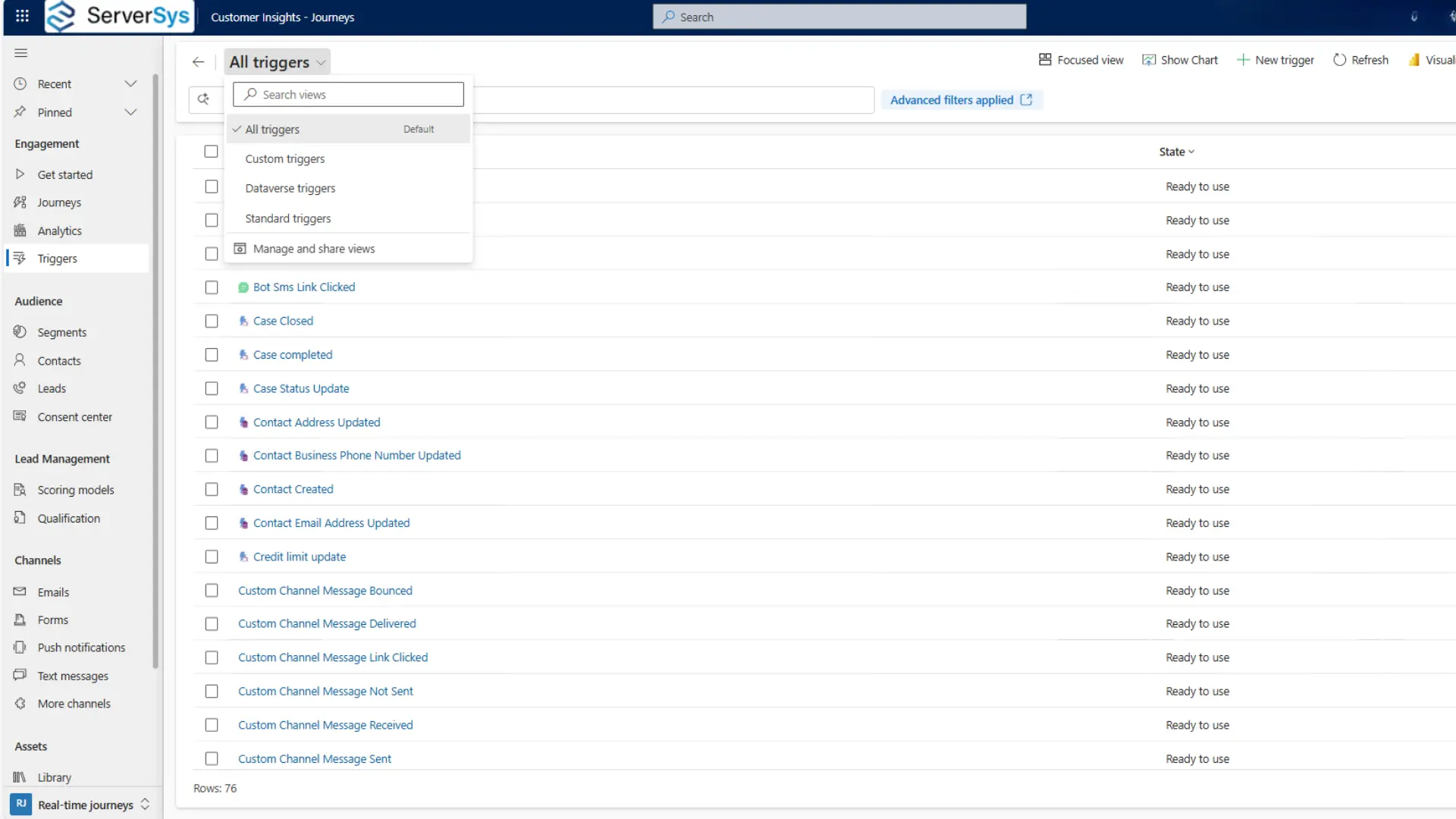Marketing teams face a persistent challenge: how do you move beyond generic, scheduled campaigns and deliver personalised messages that resonate with individuals?
While bulk email campaigns have their place, the real opportunity lies in using data to trigger timely, relevant communications based on customer behaviour, key dates, and updates in your CRM.
Dynamics 365 Customer Insights offers a solution through its trigger-based marketing journey capabilities. These triggers enable you to respond in real-time to customer actions and events, creating personalised experiences that drive engagement and build stronger relationships.
Understanding Triggers in Customer Insights
Triggers represent the bridge between your customer data and marketing action. They monitor specific customer behaviours, database entries, or time-based conditions, automatically initiating personalised messages when these conditions are met.
Unlike scheduled campaigns that send messages at predetermined times, triggers respond to real-time activity and business changes.
Dynamics 365 Customer Insights uses three types of triggers:
- Interaction triggers respond to customer engagement with marketing channels, such as email, SMS, and push notifications.
- Business triggers activate when changes occur in connected Dynamics 365 applications such as Sales or Service.
- Custom triggers capture unique business events specific to your organisation.
The foundation for all trigger-based marketing is in two core data sources within the Microsoft platform.
- Dataverse is the central repository for business data from Dynamics 365 applications, capturing transactions, customer interactions, and business processes across sales, service, and other connected modules.
- Customer Insights – Data functions as a comprehensive Customer Data Platform (CDP), unifying information from multiple external sources, including e-commerce platforms, external marketing services, and third-party systems.
While you may have data spread across numerous systems and touchpoints, effective trigger implementation requires this information to flow into either Dataverse or Customer Insights CDP profiles. Using prebuilt connectors and APIs these integrations now present fewer challenges to implement.
This unified data foundation enables sophisticated trigger conditions that consider multiple data sources simultaneously. As a result, you can create highly targeted messages based on defined scenarios rather than isolated interactions.
The ability to connect data from just about any touchpoint creates a comprehensive view necessary for meaningful, personalised engagement.
Let’s explore some trigger examples.
Behaviour Triggers
Customer behaviour provides rich insights into intent and interest. Dynamics 365 Customer Insights captures these interactions and transforms them into trigger opportunities.
Visiting specific web pages creates opportunities for targeted follow-up based on demonstrated interest. If a prospect visits your pricing page multiple times, this behaviour signals purchase consideration. A trigger can automatically send personalised pricing information or schedule a consultation call, capitalising on this interest while it remains active.
Downloading resources may indicate deeper engagement with your content. For example, customers who download gated PDF guides have moved beyond casual browsing. Triggers can nurture this engagement by sending related resources, inviting them to webinars, or connecting them with sales representatives who specialise in their area of interest.
Added items to a basket or wish list represent purchase intent that requires careful nurturing. For instance, triggers can send personalised recommendations, limited-time offers, or contextual product information that addresses frequent questions. The timing and content of these messages can significantly influence conversion rates by providing the right information at the crucial moment of decision.
Clicking on a specific call-to-action demonstrates engagement with a particular offer or content theme. This behaviour enables highly targeted follow-up that builds on the customer’s demonstrated interests. Triggers can segment customers based on their specific interactions, ensuring subsequent communications align with their preferences and needs.
Opened or clicked a marketing email provides immediate feedback on campaign effectiveness and customer engagement levels. These triggers enable dynamic campaign optimisation, automatically adjusting message frequency and content based on individual response patterns. High-engagement customers might receive more frequent communications, while less responsive contacts receive different messaging approaches.
Performed in-app actions offer insights into product usage and feature adoption. For software companies, triggers based on feature usage can guide onboarding sequences, highlight advanced capabilities, or identify opportunities for expansion. These behavioural insights enable product-led growth strategies that align marketing efforts with actual usage patterns.
Offer code used confirms successful campaign conversion and provides opportunities for added engagement. These triggers can thank customers for their purchase, suggest complementary products, or invite them to loyalty programmes. Understanding which offers resonate with specific customer segments will inform future campaigns.
Form-Based Triggers
Form submissions demonstrate customer interest and provide clear opportunities for immediate, relevant follow-up. These triggers ensure no lead or customer inquiry goes unacknowledged while enabling personalised response strategies.
Newsletter signup indicates interest in ongoing communication and brand updates. These triggers can send welcome messages, set expectations for future communications, and provide immediate value through exclusive content or offers.
Event registration creates opportunities for pre-event engagement and post-event follow-up. Triggers can send confirmation details, share preparation materials, provide networking opportunities, or gather additional attendee information. Post-event triggers can share recordings, collect feedback, or promote related events and resources.
Quote requests represent high-intent prospects requiring an immediate, professional response. These triggers can acknowledge receipt, provide estimated response times, share relevant case studies, or connect prospects with appropriate sales representatives. Quick responses to quote requests significantly influence conversion rates and customer perceptions.
Satisfaction surveys submitted provide valuable feedback that requires acknowledgement and action. These triggers may thank customers for their input, explain how feedback will be used, or initiate follow-up conversations for specific concerns.
Trigger Dates and Time-Based Triggers
Time-based triggers use significant dates and milestones to create meaningful connections. These triggers ensure your organisation never misses opportunities to engage customers at personally significant moments or critical business junctures.
Customer birthdays represent a personal touchpoint that can contribute to an emotional connection with a brand. Birthday triggers can send personalised greetings, special offers, or exclusive access to products and services. The key lies in making these communications feel genuine rather than purely transactional, strengthening the customer relationship through thoughtful recognition.
Anniversary of first purchase or registration celebrates the customer relationship and provides opportunities for appreciation and retention. These triggers can acknowledge customer loyalty, offer anniversary discounts, or share personalised insights about their journey with your organisation. Long-term customers often respond positively to recognition of their ongoing relationship.
Contract renewal or expiry date ensures critical communications never fall through the cracks. These triggers can initiate renewal discussions well before expiry dates, provide contract summaries, or offer upgrade opportunities. Proactive communication around contract dates demonstrates professionalism and helps maintain business continuity.
Subscription or trial period ending soon creates urgency while providing value-focused messaging. These triggers can highlight unused features, share success stories from similar customers, or offer incentives to convert. The timing and messaging of these communications have a significant influence on conversion rates from trial to paid subscriptions.
Updates in CRM or Customer Profile
CRM updates and profile changes may signal significant changes in customer status or circumstances. These triggers enable an immediate response to changing customer situations, ensuring communications remain relevant and timely.
Changes in customer status, such as upgrades to “premium” services or account suspensions, require immediate communication. Premium customers might receive exclusive content and priority support information, while suspended accounts need clear guidance on resolution steps. These triggers ensure customer communications always reflect their current status and needs.
Updated contact information or preferences provide opportunities to confirm changes and adjust communication strategies. When customers update their preferences, triggers can acknowledge these changes and explain how future communications will be tailored to reflect their choices. This responsiveness builds trust and demonstrates respect for customer preferences.
Goals achieved, such as completed onboarding or loyalty milestones, deserve recognition and celebration. These triggers can congratulate customers on their achievements, unlock new features or benefits, and suggest the next steps in their journey. Recognising customer progress strengthens engagement and encourages continued interaction with your products and services.
Change in detected sentiment enables proactive customer service and retention efforts. When sentiment analysis indicates declining satisfaction, triggers can initiate outreach from customer success teams, offer additional support resources, or provide feedback channels to address the issue. Early intervention based on changes in sentiment can prevent customer churn and improve overall satisfaction.
Lead score changes signal a shift in purchase intent that requires immediate sales attention. When lead scores increase significantly, triggers can alert sales teams, provide updated lead information, or initiate targeted nurturing campaigns. Conversely, declining scores might trigger re-engagement campaigns or lead qualification reviews.
Inaction or Lack of Engagement
Sometimes, the absence of activity provides the most crucial trigger opportunities. These triggers identify customers who may need re-engagement, additional support, or different communication approaches.
No purchases within a defined timeframe signal potential customer drift that requires intervention. These triggers can offer personalised recommendations, provide exclusive offers, or initiate outreach from customer success teams. Understanding why previously active customers have stopped purchasing supports targeted retention strategies.
No recent customer log-in indicates a decline in engagement with digital platforms or services. These triggers can send reminders, share new feature announcements, or offer training resources to encourage re-engagement. For subscription services, login frequency often correlates with renewal likelihood, making these triggers crucial for retention.
Not completing onboarding steps represents missed opportunities for customer success and product adoption. These triggers can provide additional guidance, offer personal assistance, or simplify the onboarding process. Customers who complete onboarding typically show higher engagement and retention rates, making these triggers essential for long-term success.
Not opening or clicking recent emails suggests communication fatigue or changing preferences. These triggers can adjust email frequency, test different subject lines, or offer alternative communication channels. Understanding and responding to engagement patterns helps maintain healthy email lists and improve overall campaign performance.
The Strategic Impact of Trigger-Based Marketing
Implementing trigger-based marketing through Dynamics 365 Customer Insights can transform how you engage with your customers.
Rather than purely relying on scheduled messages to a bulk audience, triggered communications arrive at the right moment with relevant, personalised content.
This approach delivers measurable benefits. Engagement rates typically increase because messages align with individual situations and interests. Conversion rates improve as communications address specific customer actions and needs. Also, satisfaction grows when organisations demonstrate awareness of personal journeys and preferences.
The unified data foundation in Customer Insights is one of the areas that excites us the most because it enables sophisticated trigger conditions that look at multiple data sources simultaneously. This capability means you can set triggers that combine behavioural data, transaction history, demographic information, and engagement patterns that can make your communications feel personal and relevant to recipients.
Trigger-based marketing presents a significant opportunity to drive better business outcomes. The key lies in thoughtful implementation that prioritises customer value over marketing convenience.
We specialise in helping organisations implement and optimise this marketing module of Dynamics 365 to unlock these capabilities. Our expertise in data integration, customer journey design, and marketing automation will ensure your trigger strategies achieve impact to build stronger relationships.
Ready to transform your marketing approach with intelligent triggers?
Contact ServerSys to explore how Dynamics 365 Customer Insights can personalise your customer communications and drive meaningful engagement.




